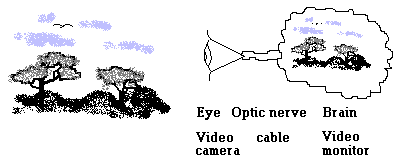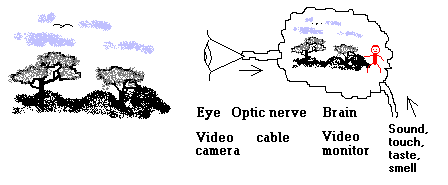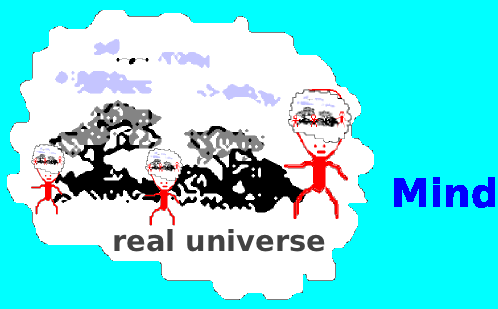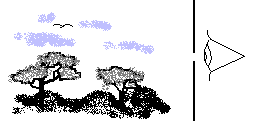A theory of reality
by Barry Kauler
Be warned, this document is a deep read! A radical viewpoint is
presented, extremely succinctly, and the argument is explained very
logically -- however, reading superficially or with bias can cause the
points to be missed entirely. One of the key points, that we are the
reverse of what we seem, not a tiny person inside a vast universe, is a
profound viewpoint that is the opposite of how we perceive ourselves and hence difficult to grasp.
Anyway, see what you can make of it...

The physical eye sees a scene, it is transferred as electrical/chemical impulses along the optic nerve to the brain, and the brain constructs a likeness, or internal image, of that scene. Right?
This is our understanding of how we perceive external events. We can conclude, to an extent, that our view of the world is pretty much up to us -- it is, after all, a reconstruction inside the brain. The same goes for all of the five senses.
The analogy used is that we are like a video camera and monitor, the camera being the eyes and the monitor being the visual-centre in the brain.
What is wrong with this concept?
The first problem is that there has to be someone to watch the monitor, which means an observer has to be sitting inside the brain watching the reconstructed image. Yes, we answer this by saying that it is our awareness or consciousness that watches.
So, there is a consciousness that is inside the brain, watching an image that is also constructed inside the brain.
There is still something fundamentally wrong!

The fundamental problem is that our perception of our body is an internal construction also. A picture of a person is added to the scene, constructed from information supplied by electrical/chemical signals from the five senses.
Sit still for a moment and become aware of your body. Yes, you can feel that you have a body, and a head, and inside the head there is grey matter that you call a brain. Think carefully about what I have just explained above -- this body that you perceive, including hands, limbs, torso, face, eyes, head, brain -- is all an internally constructed image.
It cannot be anything otherwise. This is fact. The senses are one-way, so every single thing that we know about ourselves and the universe is an internally constructed image.
This is where the paradox arises. The first picture is our normal
understanding, in which we have a physical body that
receives external data and displays it. The second picture is telling us
that even the senses and nerves that convey the
electrical/chemical signals are constructions in the mind. This means
that we have no means of identifying anything that is really
external. The second figure tells us that we don't know what our real
body is.
Even our feeling of being inside the body is contrived by the
mind. The body is constructed inside the inner world, and the mind
relocates itself inside the reconstructed body. This is such a radically opposite and counter-intuitive
perspective to what we have known all of our lives. But, it is essential to have at least an inkling
of this concept to understand the rest of this document.
We do have empirical data. We send a signal along the
internally imagined nerves to move an imagined finger and receive
imagined sensory data that it did indeed move. We see other people in
our internal landscape, and they confirm the
movement of the finger. So there is this baseline consensus. Although we
have constructed the entire universe internally, still
we are lead to believe that it is a model of something that actually
exists. Or at least, there is some kind of "common universe", regardless
of whether it "exists" or not.
We need to follow the above reasoning right through, to grasp the
truly awesome implications. Even the three spatial dimensions and
linear-time are inner concepts. In other words, we do not know that
there is any such thing as a physical spatial universe that unfolds in
linear time -- it is hypothetical only.
Most
philosopher-academics-scientists, however, have missed this point entirely...
"The elephant in the room"
This is a great saying, as it describes the situation with most philosopher-theorists and all atheists.
Again and again we see some scientist or academic say that the physical universe
is all there is, arrogantly denouncing any kind of spiritual viewpoint. However, they have to do so by ignoring the elephant.
What physical universe? Where is it?
Note, from now on I have used the words "physical universe" to denote
a standalone universe sans consciousness (but in which points of
consciousness somehow occur).
The simple explanation so far in this page proves that a physical
universe is hypothetical only. The principle of Ocam's Razor, that the
simplest explanation is the one most likely to be correct, should be
applied here -- which is that only consciousness exists.
A theorist would have to prove that a physical universe exists,
which cannot be done. Yet, most theorists start with the physical
universe as fact, and work from there. They tack on the idea that a
person might have a soul, and that the universe might have been created
by a God -- then dismiss these as unfounded speculation. However, their
reasoning is completely and utterly wrong from the first principles.
The philosopher-theoreticians also tack-on consciousness, as an
afterthought, an annoying thing that they know nothing about, yet can't
just ignore. So, they come up with a theory, such as if neurons have
sufficient complexity, they will become conscious -- which as far as
theories go, is on a par with postulating that the moon is made of green
cheese.
These are strong words, and any theorist reading this is probably jumping up and down with objections right now.
For example, the massive empirical evidence that the "outside" world
matches the inner world would strongly support a physical universe?
-- no, it only means that there is a common world, there is no evidence
at all that it exists as a separate physical reality.
Another example: there are gaps in individual consciousness, which
supports the view that there must be a separate physical universe? No,
not at all. I develop the microcosm - macrocosm model further down,
which allows for gaps in individual consciousness. Also, there is no
actual evidence that there are gaps in consciousness, only periods that
we don't remember -- if you do not experience time (as it is only a
concept anyway) and there are no thoughts, there can still be
consciousness that is not remembered afterward.
While we are on the subject of elephants, I am reminded of something.
I saw a program on TV in which someone was hypnotised and told that
there is an elephant in the room, and also a bucket of water and a
sponge, and the person was asked to wash the elephant. The remarkable
thing about that, for me, was the person was interviewed after the show,
and he said that he wasn't aware that he was hypnotised, he saw and
felt an elephant in the room, 100% real, and there was a bucket and
sponge. Furthermore, he was washing the elephant and behaving as though
this was a perfectly normal thing to be doing. I know of one hypnotist
in Australia who can on-demand induce this degree of seemingly real
experience.
But think, that person's experience makes a complete mockery of what we experience and consider to be reality.
...It is a warning that our inner experience of reality may be a very tenuous model of the actual universe.
Fundamental flaw in materialistic reasoning
The fundamental flaw in the reasoning of nearly all theorists is
exemplified in this extract from the book "The Trouble with Physics" by
Prof. Lee Smolin, in which three possibilities are given to account for the existence of the universe:
1. Ours is one of a vast collection of universes.
2. There was an intelligent designer.
3. There is a so-far-unknown mechanism. ...
Given that the first two possibilities are untestable in principle, it is most rational to hold out for the third possibility.
The part that I have put in bold is incorrect. Applying "untestable in principle" to no.2, it is a foundation stone of modern theorists, however it is an unjustified
assumption, in fact it is a statement of faith only.
It is based upon a more fundamental statement of faith, that there is a separate physical universe.
I have already proven that it is not possible to prove that the universe has a separate physical existence.
Note, option-1 given by Prof. Smolin to account for the existence of
our universe, is due to the statistical impossibility of our universe
being created by chance, as there are too many variables (or rather, the
variables have to be very precise values) -- a way around
this is to postulate a very large number of universes, even an infinite
number. Green cheese again.
Option-3 is where most theorists are now. That is, they have theories
such as String Theory, but they are all full of holes. Meaning, they
still haven't got a clue about the "big picture", just a vague hope.
Note also, that option-2 is worded very curiously indeed, as it uses
the past tense "was". The intelligent designer is without time, and the
correct tense should be "is". The macrocosm - microcosm model is
introduced below, but a comment now about time -- it is quite reasonable
to speculate that the big bang is happening at this present moment.
Microcosm versus macrocosm
There are two avenues for research into the nature of "reality". One
of them is to theorise, conduct experiments and take measurements inside
our "inner universe", that is, the world that we have constructed
inside our mind, and hope that these measurements have some relationship
with actual reality.
This is a valid, and indeed essential, line of inquiry.
The second approach is to examine the Observer, that is, the
consciousness, and try to find if this is connected in some way to a
higher consciousness, that directly "knows" something about reality,
even everything about reality.
The second approach has a sound theoretical basis, in that the
microcosm is likely to be the same as the macrocosm, as I have attempted
to represent pictorially:

That is, if there is a universal "mind", then the entire universe is
inside it, and if that mind has particularised itself into myriad
individual consciousnesses, then they would each have their entire
perception internalised, each likely to be a model of the
macro-universe.
From this model, it seems that there might be a "back door" to reality. That is, if we examine our consciousness, it might resolve back to a higher consciousness. If this can be done, then the secrets of the universe would be revealed.
At this point I really have to interject with a personal statement. I am postulating this theory after-the-fact. I know that there is a "higher mind" with access to knowledge outside of space and time.
I have had psychic experiences that have proven to me beyond any shadow of doubt that we are not bound by distance (the three spatial dimensions) nor by linear-time. For example, in the late 1990's I had a series of premonitions, thoughts of future events, that happened one after the other, to the extent that it completely ruled out chance. Also, I have had many experiences of mental communication with others, over any distance.
But, can I really say that time does not exist? My premonitions were only a short "distance" into the future (a matter of minutes), so I know that linear-time is not set-in-concrete as we think, but that does not rule out time.
Reading about someone else's experiences, or claimed experiences, is not really helpful. I have noted them here, however, the arguments presented need to be independently-rational. On the topic of time...
If the Super-Mind is timeless then so to would be the universe and the entities in it (or rather, time would be a concept only), however I have no evidence whatsoever to make any definitive statement about that. However, as the concept of time exists, it must exist at the Super-Mind level also, so even at the uncreated level the label "time" is there.
Another thing to think about: It might seem that if I was to resolve my awareness back, to a higher
mind, then I would be "outside" the individual contracted experience,
hence no longer an individual. This is however, very speculative.
Mechanism of the "back door"
I have explained that every single thing that we perceive is
hypothetical, concepts only. The question then arises, is there anything
at all that we can grasp, as "real"?
What do we have that is truly real, is not a construction or idea? There is only one thing, and the logic of this is irrefutable -- it is the "I", or awareness. This is the only thing we have to work with -- even God is only a concept inside the inner universe.

There is the fabricated inner universe and there is the real "I", the
Observer. The third
picture is a limited analogy, but it is as though the watcher is looking
through a small hole at the creation. Another analogy
would be gazing at a tiny world through a microscope -- although you are
so huge, when your attention is within the tiny
world it can seem the reverse -- that you are tiny and the world huge.
The analogy of the microscope came to me, as I recall as a child
looking through a microscope at a tiny landscape with fungal vegetation
and creatures -- I concentrated on it to such as extent that my
awareness shifted into the scene. It was as though I was a tiny creature
moving in this landscape.
If we want to understand our "true nature", or "reality", we can
focus on this one thing that we know to be true, the "I". However, as
our experience is completely from the perspective of a tiny creature in
that tiny landscape, we are still trapped. Effectively, we are trapped inside a
dream.
I have used the analogy of a small hole in a wall, due to some meditation experiences I (and many others) have had. If you can locate this centre of your awareness, you can "pop out" to a higher level of awareness. Or, just by being quiet and aware of that centre, higher knowledge can "pop through".
Using meditation, contemplation, devotion, prayer, or any other
"spiritual" practice to become aware of the higher mind (I am avoiding
the "God" word, due to all the emotive associations that come with it),
is a personal journey, however, reputable researchers can and have
documented and published experiments that verify such things as
long-distance telepathy.
I hope that you have found this page challenging and insightful!
Reference
- The Trouble With Physics, by Lee Smolin, 2006, Penguin Books, UK, ISBN: 978-0-141-01835-5
This is supposed to be written for the layperson, however it is a heavy read. I think that it is a good overview for theorists who are researching in the area, or going into it.
I originally wrote a document titled "The Truth", using a pseudonym, along with some other philosophical ramblings, back in
1999. I took it offline for a very
long time (along with all my other writings), but in late 2013 I have
completely rewritten it, and renamed to "A Theory of Reality" and used
my real name. Then it went offline again for a couple of years, have brought it back in December 2018, with slight editing.
Tags: insight
